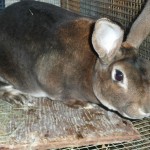by Brenda Lee S., April 2012
(photos from Nick & Brenda Lee S.)
[Cat’s Note: Nick and Brenda Lee presented on Raising Rabbits for our march 2010 gathering. See Gathering Summary: Raising Chickens & Rabbits. See also their video in 4 parts, on How to Dress (Home Butcher) a Rabbit]
My father raised rabbits starting in ‘29; he survived the depression delivering and butchering rabbits on site. He continued to raise rabbits until his death at age 81. We have been around rabbits all of our lives, having grown up with my fathers’ vast experience, and continued with our love of rabbits, breeding Rex Rabbits. Rabbits are very amazing, There are however some points to raising rabbits.
General Notes on Breeding Rabbits
The larger the rabbit breed, the longer it takes for the rabbit to reach sexual maturity: the smaller breeds can breed at 3 months; larger breeds, by 4 months. Though they reach sexual maturity at an early age, it still is better NOT to breed your rabbits until 7 months of age. The larger the breed is, the more meat you can get; however, the cost to get the meat increases due to feeding costs, etc..
Although you can breed rabbits up to four times a year, it is far better to breed your rabbits only twice a year. Rabbits that are bred four times a year, are not the best producers, kindling only 4-6 kits, and their breed length is on average 4-5 years, some as short as 3 years. By breeding twice a year, you can successfully breed your does from 5-7 years (producing 6-10 kits), and use a buck up to 6-9 years.
An example of breeding once year with 4 Rex does and 2 Rex bucks:
- Bred 2 times a year each, average kits per breeding 6. (our does average 6-10). This would be (at 6 each) 48 kits born a year.
- Rex rabbits average 4 lbs at age 6 months; output would be 192 lbs of meat a year from Rex rabbits. Higher with does that are exceptional breeders, like our Myshi handling 8-10 kits a breeding.
- We have found that the age of 4-6 months is the best butcher age for our Rex line, costing us on average 32¢ per lb of meat. After age 6 months, the cost of feeding (especially the larger breeds) increases higher than your actual return on meat.
Larger breeds, such as the New Zealand can be butchered at 3-4 months depending on the meat return you require.
Special Considerations
Problems with Different Breeds
- Flemish Giants are very high strung, somewhat the ‘princes’ mentality, requiring a lot of “maintenance”.
- California breed is known for their biting, aggressive nature, and for needing routine grooming. (This is not an absolute, but some traits are more so in one breed than another).
There is a lot of inbreeding in rabbit lines, and because of this, there can be more benefit raising a mixed breed over a Pedigree. A registered line of rabbits can be done on any breed of rabbit after a three year period (generations) in your breeding program. This means if you start with a breed of rabbit and record and maintain the line for three years/generations, you can register most lines without any further documentation than your breeding records.
Effect of Stress or Illness in Rabbits
Rabbits have a ‘fear or flight’ mentality. Meaning that they hide illnesses very well due to the instinct of preservation. Does have been known to ‘save’ their kits by letting them die, or by killing them, due to any stressful situation that can happen while they are pregnant or when they kindle. There is a 50% chance a first time doe will abandon her young; this is why it is recommended to breed a doe twice prior to making a call to cull or maintain them as a breed doe. By forcing a doe to nurse, you can in advertently ruin her as a breeder.
Triggering Heat Cycles in the Doe
Rabbits are one of the very few meat animals for which the heat cycles can be triggered for breeding. Keeping a buck within range of a doe (adjoining pen or cage) can also allow an easier time with breeding. Some does will be particular as to which buck they breed with. By placing the doe in with the buck , for a few minutes 1-2 days, you will trigger her breeding instincts.
Some recommend having the buck ‘cover’ the doe three days in a row; however, we have always allowed our bucks to cover the doe 2-3 times within a 5-10 minute period.
We find less frequent breeding to be more advantageous: your buck will last far longer as a breeder. One buck can service 10 does without any drop in health or production.
The Chase
Your doe will give indications that she wishes to breed, but first the chase! Some does will run until she allows the buck to catch her. If you watch closely, you will see the doe raise her tail to allow the buck to cover her. Some will even raise their rump to do so. The buck will than cover the doe, proceeding to ‘fall’ after a successful covering (or breeding).
Kindling
A doe’s cycle can last for 14-16 days with 4-7 day breaks. It is best not to handle a pregnant doe; the risk to the kits is significant during the 30-day gestation period. Try to place the breed box (if your cages do not contain one) one week prior to them kindling. This will allow the mother instinct to kick in with minimal stress to those that are a little high strung.
In all our years with rabbits, we have never had a rabbit kindle during the day, though we have seen signs of labor. Usual kindling is done early morning. Rabbits are very consistent with the 31 day gestation period. If a doe does not kindle in the 30 day period, there could be a problem.
Does can, and have, absorbed the embryos; it is unusual, but possible, especially If they do not ‘like the buck’. While some vets do not agree with this statement, quite a few vets (one with 40 years of rabbit knowledge) agree with my father’s experience.
Does can abandon their young if there are genetic issues as well, short of an ‘autopsy,’ natural instincts may have reasons you will never be able to find. Note the times that your doe will raise 6-7 kits successfully; however, one was half eaten in the box. Not a pleasant picture, but it is a fact when dealing with rabbits.
When & How to Check the Kits
Do not be tempted to check out the kits for the first week, especially with a new breeder doe, as most does do not like this intrusion. Look for increased signs of movement inside the box. As the days progress you will see more movement under all that few and straw.
Yes, you will lose some kits, especially with a first time breeder, but it offsets any risk of ‘ruining’ the doe as a future breeder. Once you are familiar with your does, then you know which one you can peak in on and which don’t care for it at all. Does will occasionally have a kit outside of the box, don’t panic, most likely one little kit decided breakfast WAS NOT OVER! Have gloves on hand to remove any possibility of your scent on the kit and slowly place them back in the box.
One vs Two Bucks
Our reasoning of having two breed bucks is simple.
- Avoid line-breeding: although this can continue a desired trait, it can also carry bad health traits and affect quality of the meat. When you find an exceptional doe line (Myshi again as our example giving us 8-10 kits a breeding), you can continue with her doe offspring, using the second buck for their breeding.
- If your line reaches their limits as viable breeders, you can have does from one group and a buck from the second group and continue with your best line, thus giving you the potential of meat for up to 10-15 years or more. Quite remarkable when you consider it in this light.
Detecting Illness
It is very difficult to diagnose an illness with your rabbits. You need to ‘get to know’ your rabbits to understand when they are stressed or sick.
- Excessive licking is one of the best indicators that your rabbit is ill.
- Excessive water drinking can also be a sign.
- We recommend always looking at their eyes and nose for any discharge.
- Feel their backs for weight changes.
- Fecal chain: a rabbit with stomach issues will produce a fecal chain and then consume it. The organisms [probiotics] in the fecal chain will help them regulate digestive problems. [See also the next section for more on this.]
- Check the scent glands on either side of the anus for discharge of a ‘waxy’ nature. You will need to clean this area when needed; usually you will note an off-odor indicating the scent glands need to be cleaned. Clogged scent glands can cause a bad infection.
- As to stress, each animal will have different stressors in their environment. We have one doe that you CANNOT use a tiller or mower during her 31 gestation period. As we stated earlier, learn your rabbits.
Raising a Kit (Without the Doe)
Now for the least favorite topic, trying to raise a kit. This is very difficult – athough we have successfully done this 3 times, it still doesn’t help those who lose them after trying so hard to raise them.
There is an important piece of information to note regarding hand raising baby rabbits: there is a window of ‘three weeks’. If you can get the kits beyond the three week period then you have accomplished what was needed.
The doe provides a ‘chain’, this is a tiny string of fecal pearls, and this is fed to her kits. This is as important to the kits, as colostrum is to kid goats. Without this ‘chain’ the kits digestive tract cannot develop correctly. This is the main cause of unsuccessful rearing of kits.
There are a few things you can do if you find kits are now your responsibility. But nothing is better than the doe raising her own young.
- First, probiotics, if the doe is not nursing or dries up, adding probiotics to the feeding schedule is an absolute must.
- Colostrum is also a great substitute to the chain.
- Take into consideration that rabbits can very easily aspirate fluids into their lungs. Feedings must be very carefully given to prevent this.
- NEVER force a feeding to the kit, too much to fast will cause aspiration, feed drops at a time. Though the doe usually only feeds twice a day, we have had more frequent feedings (when hand raising) to limit the amount given at any one time.
- We have even carried the kits in a fanny pack lined with rabbit fur to work. Very much a sight to see, but very beneficial to the kits, mimicking the breed box.
Second method, (not the best), is to breed two does at the same time. You can then substitute one doe for another. This is not as easy as it sounds though.
- You must cover the scent of the kits, thereby confusing the doe by preventing her from distinguishing her kits from the new kits. Usually, something strong like Vicks on the tip of her nose,
- Wear sterile gloves when placing the kits in with ‘mom’.
- And yes, you can do all the ‘right’ things and still lose the adorable little kits. It is not an ‘exact’ science, but with more knowledge you are better able to deal with the times when they are needed.

